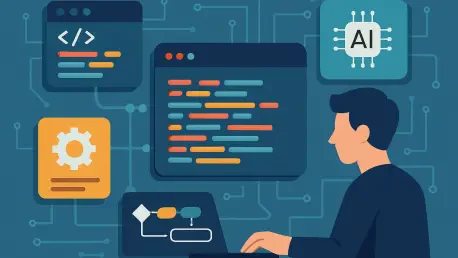In a world where software powers everything from hospital systems to social media feeds, a staggering statistic reveals a hidden crisis: nearly 70% of software projects face delays or failures due to unmanageable complexity, according to recent industry reports. This chaos often stems from sprawling, tangled codebases that even seasoned developers struggle to navigate. Picture a critical healthcare app crashing mid-operation because a single update broke an unseen connection. Such high-stakes scenarios underscore an urgent need for a smarter approach to software design—one that could harness the precision of artificial intelligence to untangle the mess and redefine how coding is done.
The significance of this challenge cannot be overstated. As software systems grow more intricate, the risk of catastrophic failures in essential sectors like healthcare, finance, and transportation escalates. Developers are caught in a bind, juggling fragmented features while businesses and users demand reliability. A groundbreaking model from leading researchers offers a potential lifeline: modular software paired with AI integration. This approach promises not just to simplify coding but to transform it into a more transparent, efficient, and trustworthy process, addressing the root causes of today’s digital dilemmas.
Why Is Software Complexity a Barrier to Progress?
Modern software systems resemble labyrinths, with lines of code weaving across countless services and functions, often leading to unexpected breakdowns. A single feature, like a notification alert in a messaging app, might span multiple subsystems—user interface, database, and server logic—making it a nightmare to update or debug. When a glitch disrupts a vital service, such as a hospital’s patient tracking system, the consequences can be dire, highlighting how complexity directly threatens safety and efficiency in critical domains.
Beyond immediate risks, this tangled structure slows innovation as developers spend more time deciphering existing code than building new solutions. Industry surveys indicate that up to 50% of development time is consumed by maintenance rather than creation, a statistic that frustrates tech teams and inflates project costs. The burden of managing such intricate systems calls for a radical shift in how software is conceptualized and constructed, paving the way for alternatives that prioritize clarity over chaos.
Addressing the Crisis in Software Design with AI Challenges
As software complexity mounts, the fragmentation of features across disjointed services exacerbates the struggle for developers tasked with maintenance. A simple update to a social media platform’s “like” button, for instance, might require changes in half a dozen unrelated modules, risking errors with each tweak. This scattered approach not only delays progress but also increases the likelihood of bugs slipping through, a problem that impacts end-users with inconsistent or broken experiences.
Compounding the issue is the rise of AI tools, particularly large language models (LLMs), which assist in coding but often generate disorganized or error-prone outputs due to a lack of structured guidelines. While these tools can churn out code at impressive speeds, their results frequently require extensive rework, especially in high-stakes fields like medical software where precision is non-negotiable. The intersection of design flaws and AI limitations underscores a pressing need for frameworks that can impose order on both human and machine contributions.
The broader implications touch everyone reliant on technology, from businesses facing downtime to users frustrated by unreliable apps. With software failures costing the global economy billions annually, according to recent economic studies, the push for reliability in an AI-driven era becomes a shared priority. Solutions that bridge the gap between complex systems and intelligent automation are not just desirable—they are essential for sustainable digital growth.
Exploring the Concepts and Synchronizations Model for Modular Software
A promising framework from MIT’s Computer Science and Artificial Intelligence Laboratory introduces a fresh perspective through “concepts” and “synchronizations.” Concepts are defined as self-contained modules that encapsulate specific functionalities, such as the entire logic for a “share” feature in an app, including its state and actions. This localized design contrasts sharply with traditional methods where such logic is dispersed, making it easier to manage and modify without unintended ripple effects.
Synchronizations, meanwhile, serve as explicit rules that dictate how these modules interact, acting like clear contracts that prevent ambiguity. For example, a synchronization might ensure that a shared post triggers a notification only after database confirmation, avoiding inconsistencies. A case study from the research demonstrates this in action, showing how centralizing a social media feature into one concept, governed by defined synchronizations, ensures consistent behavior across platforms, reducing errors significantly.
This modular approach tackles fragmentation head-on by organizing software into intuitive, independent units while maintaining strict interaction protocols. Such structure not only enhances readability but also lays a foundation for seamless integration with AI tools, which can leverage these clear boundaries to generate more accurate code. The model’s emphasis on transparency offers a blueprint for rethinking software architecture in a way that aligns with both human understanding and machine efficiency.
Insights from Experts and Real-World Applications
Voices from the field lend weight to the potential of this modular framework, with Professor Daniel Jackson advocating for software that mirrors the clarity of a well-written book. His vision emphasizes transparency, arguing that developers should grasp a system’s intent at a glance, a sentiment echoed by many in the industry. Associate Professor Kevin Sullivan from the University of Virginia adds a critical perspective, describing current software practices as “costly and frustrating,” often posing risks in essential applications due to their opacity.
Further validation comes from Thomas Ball of Lancaster University, who highlights the model’s compatibility with large language models, noting its ability to translate design intent into actionable code through AI. A developer’s account from a recent project illustrates the contrast starkly: wrestling with fragmented code for weeks to fix a minor bug became a turning point when considering modular alternatives. This real-world frustration underscores the model’s appeal, grounding its technical promise in tangible, relatable struggles faced by coding professionals daily.
The consensus among these experts points to a transformative shift, where modularity could redefine development workflows. Their insights, paired with practical anecdotes, suggest that adopting such a system might not only solve immediate pain points but also foster a culture of precision and accountability in software creation. This blend of academic rigor and hands-on relevance builds a compelling case for broader adoption across tech sectors.
Practical Steps for Implementing Modular Software with AI Tools
For developers and tech leaders ready to embrace this paradigm, a structured approach to integrating modular software with AI begins with identifying core functionalities to isolate as concepts. This means pinpointing distinct features—like a payment gateway in an e-commerce app—and encapsulating their logic into standalone modules. Such segmentation streamlines updates and minimizes cross-system errors, setting a solid base for further innovation.
Next, employing a domain-specific language (DSL) to define synchronizations ensures that interactions between concepts remain explicit and predictable. Teams can then integrate AI tools, such as large language models, to automate code generation within these defined structures, leveraging the clarity of modules to reduce mistakes. Exploring “concept catalogs”—repositories of reusable, pre-tested components—can further accelerate development by providing ready-made building blocks tailored to specific domains.
Key recommendations include prioritizing transparency in design to aid collaboration and rigorously testing synchronizations to confirm consistent behavior across scenarios. These actionable steps empower teams to transform coding practices, harnessing modularity and AI in tandem to build more robust systems. By adopting this framework, the development community can move toward efficiency and reliability, addressing long-standing challenges with practical, forward-thinking solutions.
Reflecting on a Path Forward
Looking back, the journey through the chaos of software complexity revealed a landscape fraught with risks, from critical system failures to stifled innovation. The exploration of a modular framework, supported by expert voices and real-world struggles, painted a picture of hope amid the challenges. Each step—from dissecting the crisis to outlining actionable strategies—built a narrative of transformation that resonated with the urgent needs of developers and users alike.
Moving ahead, the focus must shift to widespread adoption of modular designs, encouraging tech leaders to pilot these concepts in smaller projects before scaling up. Collaboration across industries could accelerate the creation of shared concept catalogs, fostering standardization and reducing redundant efforts. As AI continues to evolve, integrating it with structured models like this one offers a chance to redefine coding as a discipline of precision and intent.
Ultimately, the next phase lies in sustained experimentation and advocacy for transparency, ensuring that software becomes a tool of trust rather than uncertainty. Developers are urged to test these principles in diverse applications, from healthcare to consumer tech, documenting outcomes to refine the approach. This collective effort holds the promise of a future where technology serves with clarity and reliability, meeting the demands of an ever-digital world.









